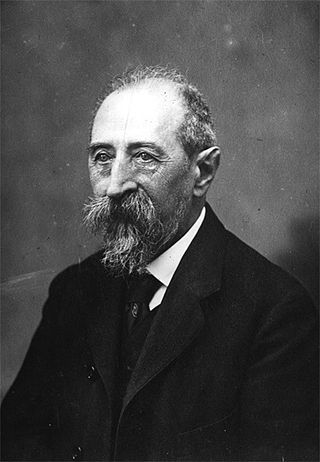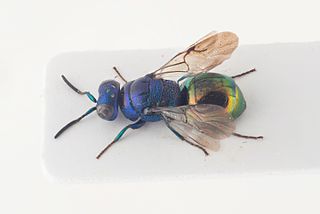Maximilian Spinola was an Italian entomologist.

Potter wasps, the Eumeninae, are a cosmopolitan wasp group presently treated as a subfamily of Vespidae, but sometimes recognized in the past as a separate family, Eumenidae.

Commonly known as cuckoo wasps or emerald wasps, the hymenopteran family Chrysididae is a very large cosmopolitan group of parasitoid or kleptoparasitic wasps, often highly sculptured, with brilliant metallic colors created by structural coloration. They are most diverse in desert regions of the world, as they are typically associated with solitary bee and wasp species, which are also most diverse in such areas. Their brood parasitic lifestyle has led to the evolution of fascinating adaptations, including chemical mimicry of host odors by some species.

Carlo Emery was an Italian entomologist. He is remembered for Emery's rule, which states that insect social parasites are often closely related to their hosts.
RaffaelloGestro was an Italian entomologist who specialised in Coleoptera. Gestro was the Director of the Natural History Museum of Giacomo Doria Genoa where his collection is conserved. He was a Member and President of the Italian Entomological Society.
Pietro Mansueto Ferrari was an Italian entomologist who specialised in Hemiptera, particularly Auchenorrhyncha.
Psiliglossa is a circum-Mediterranean and Central-Asian genus of potter wasps with seven known species.

Chrysis is a very large genus of cuckoo wasps. It is the largest genus in the family, including over 1,000 species, as large as the rest of the Chrysididae together. The generic name is derived from Greek chrysis, "gold vessel, gold-embroidered dress", and pays tribute to the brilliant metallic appearance of wasps in the genus.
Emilio Berio was an Italian entomologist and lawyer.

Chrysis ignita is a species of cuckoo wasp. It is one of a group of species which are difficult to separate and which may be referred to as ruby-tailed wasps. Cuckoo wasps are kleptoparasites – they lay their eggs in the nests of other species and their young consume the eggs or larva of the host for sustenance. These wasps have a number of adaptations which have evolved to equip them for their life cycle. Chrysis ignita parasitize mason bees in particular. Ruby-tailed wasps have metallic, armored bodies, and can roll up into balls to protect themselves from harm when infiltrating the nests of host bees and wasps. Unlike most other aculeates, cuckoo wasps cannot sting. Chrysis ignita is found across the European continent.

Pseudomalus auratus is a species of cuckoo wasp.
Antonio Giordani Soika was an Italian entomologist, ecologist and director of the Civic Museum of Natural History of Venice. He had a long career in which he worked on various groups of insects but much of his work was on the Hymenoptera. He made great contributions to the knowledge of Neotropical wasps, especially potter wasps for which he produced many taxonomic keys and also monographs on the systematics of the wasp family Vespidae.
Giovanni Gribodo was an Italian civil engineer, architect and entomologist. As an architect he was part of the Art Nouveau architectural movement known as the Liberty style, while as an entomologist, he was an important contributor to the global knowledge of the insect order Hymenoptera.
Stigmus americanus is a species of aphid wasp in the family Crabronidae. It is found in North America.

Chrysura simplex is a species of cuckoo wasps, insects in the family Chrysididae.

Teretia nana is an extinct species of sea snail, a marine gastropod mollusk in the family Raphitomidae.

Omalus is a genus of cuckoo wasps in the family Chrysididae.

Omalus biaccinctus is a species of cuckoo wasps belonging to the family Chrysididae.

Chrysis fulgida, the ruby-tailed wasp, is a species of cuckoo wasp in the family Chrysididae.













